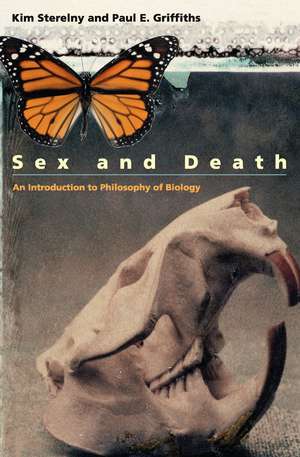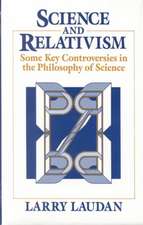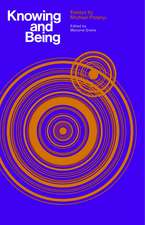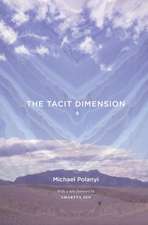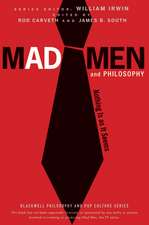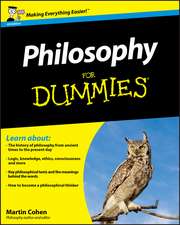Sex and Death: An Introduction to Philosophy of Biology: Science and Its Conceptual Foundations series
Autor Kim Sterelny, Paul E. Griffithsen Limba Engleză Paperback – 15 iun 1999
Is the history of life a series of accidents or a drama scripted by selfish genes? Is there an "essential" human nature, determined at birth or in a distant evolutionary past? What should we conserve—species, ecosystems, or something else?
Informed answers to questions like these, critical to our understanding of ourselves and the world around us, require both a knowledge of biology and a philosophical framework within which to make sense of its findings. In this accessible introduction to philosophy of biology, Kim Sterelny and Paul E. Griffiths present both the science and the philosophical context necessary for a critical understanding of the most exciting debates shaping biology today. The authors, both of whom have published extensively in this field, describe the range of competing views—including their own—on these fascinating topics.
With its clear explanations of both biological and philosophical concepts, Sex and Death will appeal not only to undergraduates, but also to the many general readers eager to think critically about the science of life.
Informed answers to questions like these, critical to our understanding of ourselves and the world around us, require both a knowledge of biology and a philosophical framework within which to make sense of its findings. In this accessible introduction to philosophy of biology, Kim Sterelny and Paul E. Griffiths present both the science and the philosophical context necessary for a critical understanding of the most exciting debates shaping biology today. The authors, both of whom have published extensively in this field, describe the range of competing views—including their own—on these fascinating topics.
With its clear explanations of both biological and philosophical concepts, Sex and Death will appeal not only to undergraduates, but also to the many general readers eager to think critically about the science of life.
Din seria Science and Its Conceptual Foundations series
-
 Preț: 230.35 lei
Preț: 230.35 lei -
 Preț: 455.04 lei
Preț: 455.04 lei -
 Preț: 431.17 lei
Preț: 431.17 lei -
 Preț: 288.59 lei
Preț: 288.59 lei -
 Preț: 294.80 lei
Preț: 294.80 lei -
 Preț: 231.00 lei
Preț: 231.00 lei -
 Preț: 191.68 lei
Preț: 191.68 lei -
 Preț: 274.82 lei
Preț: 274.82 lei -
 Preț: 443.89 lei
Preț: 443.89 lei -
 Preț: 358.60 lei
Preț: 358.60 lei -
 Preț: 498.55 lei
Preț: 498.55 lei -
 Preț: 392.61 lei
Preț: 392.61 lei -
 Preț: 352.99 lei
Preț: 352.99 lei -
 Preț: 347.24 lei
Preț: 347.24 lei -
 Preț: 320.04 lei
Preț: 320.04 lei -
 Preț: 448.30 lei
Preț: 448.30 lei -
 Preț: 389.89 lei
Preț: 389.89 lei -
 Preț: 317.33 lei
Preț: 317.33 lei -
 Preț: 496.35 lei
Preț: 496.35 lei -
 Preț: 435.78 lei
Preț: 435.78 lei -
 Preț: 401.43 lei
Preț: 401.43 lei -
 Preț: 447.32 lei
Preț: 447.32 lei -
 Preț: 387.98 lei
Preț: 387.98 lei -
 Preț: 233.11 lei
Preț: 233.11 lei -
 Preț: 385.65 lei
Preț: 385.65 lei -
 Preț: 331.75 lei
Preț: 331.75 lei -
 Preț: 270.07 lei
Preț: 270.07 lei -
 Preț: 268.20 lei
Preț: 268.20 lei - 15%
 Preț: 194.45 lei
Preț: 194.45 lei - 22%
 Preț: 689.51 lei
Preț: 689.51 lei - 23%
 Preț: 583.39 lei
Preț: 583.39 lei - 10%
 Preț: 306.24 lei
Preț: 306.24 lei - 15%
 Preț: 264.92 lei
Preț: 264.92 lei
Preț: 301.88 lei
Nou
Puncte Express: 453
Preț estimativ în valută:
57.77€ • 60.09$ • 47.69£
57.77€ • 60.09$ • 47.69£
Carte tipărită la comandă
Livrare economică 14-28 aprilie
Preluare comenzi: 021 569.72.76
Specificații
ISBN-13: 9780226773049
ISBN-10: 0226773043
Pagini: 456
Ilustrații: 16 halftones, 25 line drawings
Dimensiuni: 152 x 229 x 30 mm
Greutate: 0.68 kg
Ediția:1
Editura: University of Chicago Press
Colecția University of Chicago Press
Seria Science and Its Conceptual Foundations series
ISBN-10: 0226773043
Pagini: 456
Ilustrații: 16 halftones, 25 line drawings
Dimensiuni: 152 x 229 x 30 mm
Greutate: 0.68 kg
Ediția:1
Editura: University of Chicago Press
Colecția University of Chicago Press
Seria Science and Its Conceptual Foundations series
Cuprins
Preface
Part I - Theory Really Matters: Philosophy of Biology and Social Issues
1.1. The Science of Life Itself
1.2. Is There an Essential Human Nature?
1.3. Is Genuine Altruism Possible?
1.4. Are Human Beings Programmed by Their Genes?
1.5. Biology and the Pre-emption of Social Science
1.6. What Should Conservationists Conserve?
2. The Received View of Evolution
2.1. The Diversity of Life
2.2. Evolution and Natural Selection
2.3. The Received View and Its Challenges
Part II - Genes, Molecules, and Organisms
3. The Gene's Eye View of Evolution
3.1. Replicators and Interactors
3.2. The Special Status of Replicators
3.3. The Bookkeeping Argument
3.4. The Extended Phenotype
4. The Organisim Strikes Back
4.1. What Is a Gene?
4.2. Genes Are Active Germ Line Replicators
4.3. Genes Are Difference Makers
5. The Developmental Systems Alternative
5.1. Gene Selectionism and Development
5.2. Epigenetic Inheritance and Beyond
5.3. The Interactionist Consensus
5.4. Information in Development
5.5. Other Grounds for Privileging Genes
5.6. Developmental Systems and Extended Replicators
5.7. One True Story?
6. Mendel and Molecules
6.1. How Theories Relate: Displacement, Incorporation, and Integration
6.2. What Is Mendelian Genetics?
6.3. Molecular Genetics: Transcription and Translation
6.4. Gene Regulation
6.5. Are Genes Protein Makers?
7. Reduction: For and Against
7.1. The Antireductionist Consensus
7.2. Reduction by Degrees?
7.3. Are Genes DNA Sequences Plus Contexts?
7.4. The Reductionist Anticonsensus
Part III - Organisms, Groups, and Species
8. Organisms, Groups, and Superorganisms
8.1. Interactors
8.2. The Challenge of Altruism
8.3. Group Selection: Take 1
8.4. Group Selection: Take 2
8.5. Population-Structured Evolution
8.6. Organisms and Superorganisms
9. Species
9.1. Are Species Real?
9.2. The Nature of Species
9.3. The One True Tree of Life
9.4. Species Selection
Part IV - Evolutionary Explanations
10. Adaptation, Perfection, Function
10.1. Adaptation
10.2. Function
10.3. The Attack on Adaptationism
10.4. What Is Adaptationism?
10.5. Structuralism and the Bauplan
10.6. Optimality and Falsifiability
10.7. Adaptation and the Comparative Method
11. Adaptation, Ecology, and the Environment
11.1. The Received View in Ecology
11.2. History and Theory in Ecology
11.3. The Balance of Nature
11.4. Niches and Organisms
11.5. Reconstructing Niches
11.6. Unfinished Business
12. Life on Earth: The Big Picture
12.1. The Arrow of Time and the Ladder of Progress
12.2. Gould's Challenge
12.3. What Is Disparity?
12.4. Contingency and Its Consequences
12.5. Mass Extinction and the History of Life
12.6. Conclusions
Part V - Evolution and Human Nature
13. From Sociobiology to Evolutionary Psychology
13.1. 1975 and All That
13.2. The Wilson Program
13.3. From Darwinian Behaviorism to Darwinian Psychology
13.4. Evolutionary Psychology and Its Promise
13.5. Evolutionary Psychology and Its Problems
13.6. Memes and Cultural Evolution
14. A Case Study: Evolutionary Theories of Emotion
14.1. Darwin on the Emotions
14.2. Sociobiology and Evolutionary Psychology on the Emotions
14.3. The Modular Emotions
14.4. Beyond the Modular Emotions
14.5. Emotion, Evolution, and Evolved Psychology
Part VI - Concluding Thoughts
15. What Is Life?
15.1. Defining Life
15.2. Universal Biology
15.3. Simulation and Emergence
Final Thoughts
Glossary
References
Index
Part I - Theory Really Matters: Philosophy of Biology and Social Issues
1.1. The Science of Life Itself
1.2. Is There an Essential Human Nature?
1.3. Is Genuine Altruism Possible?
1.4. Are Human Beings Programmed by Their Genes?
1.5. Biology and the Pre-emption of Social Science
1.6. What Should Conservationists Conserve?
2. The Received View of Evolution
2.1. The Diversity of Life
2.2. Evolution and Natural Selection
2.3. The Received View and Its Challenges
Part II - Genes, Molecules, and Organisms
3. The Gene's Eye View of Evolution
3.1. Replicators and Interactors
3.2. The Special Status of Replicators
3.3. The Bookkeeping Argument
3.4. The Extended Phenotype
4. The Organisim Strikes Back
4.1. What Is a Gene?
4.2. Genes Are Active Germ Line Replicators
4.3. Genes Are Difference Makers
5. The Developmental Systems Alternative
5.1. Gene Selectionism and Development
5.2. Epigenetic Inheritance and Beyond
5.3. The Interactionist Consensus
5.4. Information in Development
5.5. Other Grounds for Privileging Genes
5.6. Developmental Systems and Extended Replicators
5.7. One True Story?
6. Mendel and Molecules
6.1. How Theories Relate: Displacement, Incorporation, and Integration
6.2. What Is Mendelian Genetics?
6.3. Molecular Genetics: Transcription and Translation
6.4. Gene Regulation
6.5. Are Genes Protein Makers?
7. Reduction: For and Against
7.1. The Antireductionist Consensus
7.2. Reduction by Degrees?
7.3. Are Genes DNA Sequences Plus Contexts?
7.4. The Reductionist Anticonsensus
Part III - Organisms, Groups, and Species
8. Organisms, Groups, and Superorganisms
8.1. Interactors
8.2. The Challenge of Altruism
8.3. Group Selection: Take 1
8.4. Group Selection: Take 2
8.5. Population-Structured Evolution
8.6. Organisms and Superorganisms
9. Species
9.1. Are Species Real?
9.2. The Nature of Species
9.3. The One True Tree of Life
9.4. Species Selection
Part IV - Evolutionary Explanations
10. Adaptation, Perfection, Function
10.1. Adaptation
10.2. Function
10.3. The Attack on Adaptationism
10.4. What Is Adaptationism?
10.5. Structuralism and the Bauplan
10.6. Optimality and Falsifiability
10.7. Adaptation and the Comparative Method
11. Adaptation, Ecology, and the Environment
11.1. The Received View in Ecology
11.2. History and Theory in Ecology
11.3. The Balance of Nature
11.4. Niches and Organisms
11.5. Reconstructing Niches
11.6. Unfinished Business
12. Life on Earth: The Big Picture
12.1. The Arrow of Time and the Ladder of Progress
12.2. Gould's Challenge
12.3. What Is Disparity?
12.4. Contingency and Its Consequences
12.5. Mass Extinction and the History of Life
12.6. Conclusions
Part V - Evolution and Human Nature
13. From Sociobiology to Evolutionary Psychology
13.1. 1975 and All That
13.2. The Wilson Program
13.3. From Darwinian Behaviorism to Darwinian Psychology
13.4. Evolutionary Psychology and Its Promise
13.5. Evolutionary Psychology and Its Problems
13.6. Memes and Cultural Evolution
14. A Case Study: Evolutionary Theories of Emotion
14.1. Darwin on the Emotions
14.2. Sociobiology and Evolutionary Psychology on the Emotions
14.3. The Modular Emotions
14.4. Beyond the Modular Emotions
14.5. Emotion, Evolution, and Evolved Psychology
Part VI - Concluding Thoughts
15. What Is Life?
15.1. Defining Life
15.2. Universal Biology
15.3. Simulation and Emergence
Final Thoughts
Glossary
References
Index
